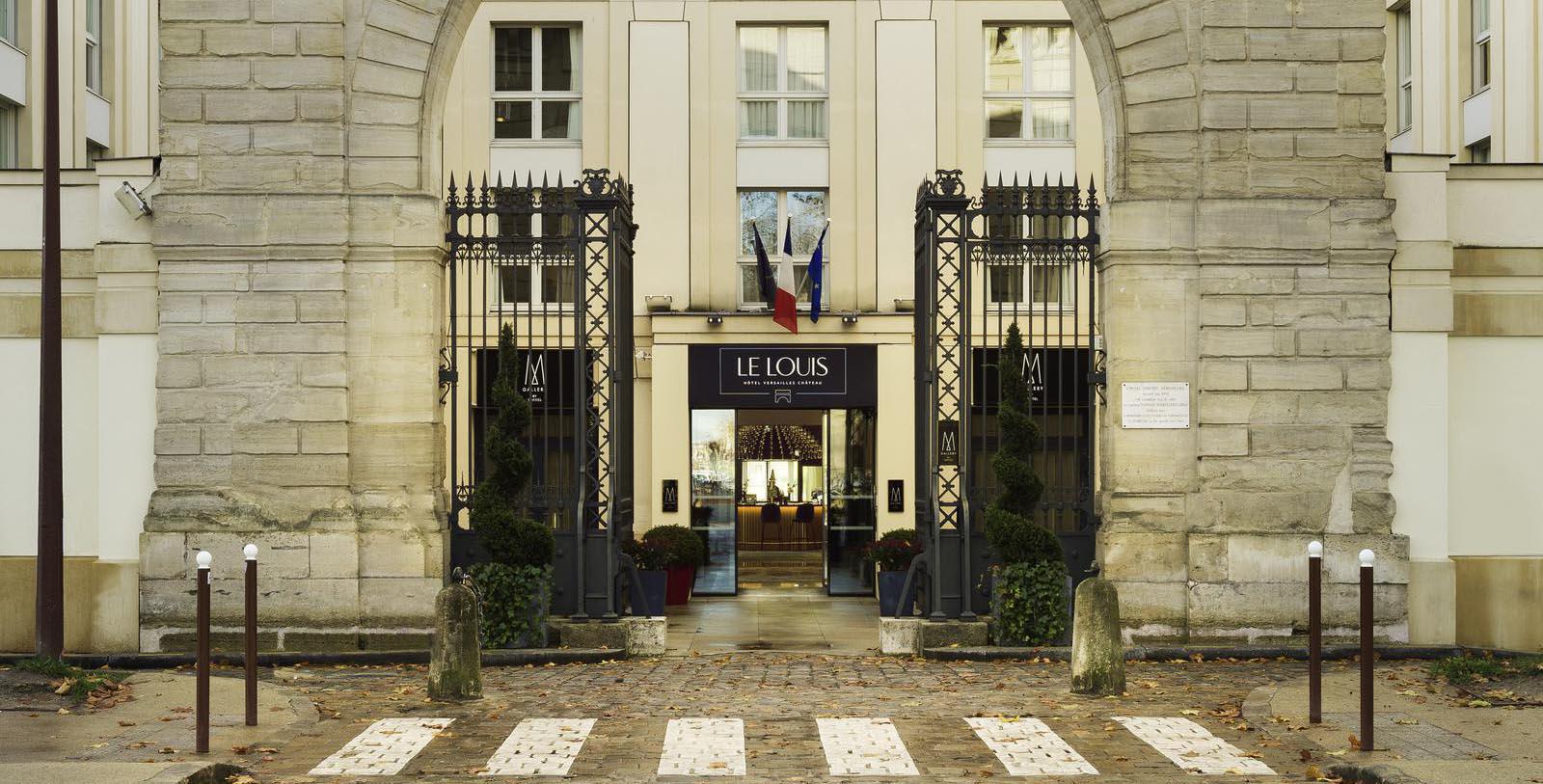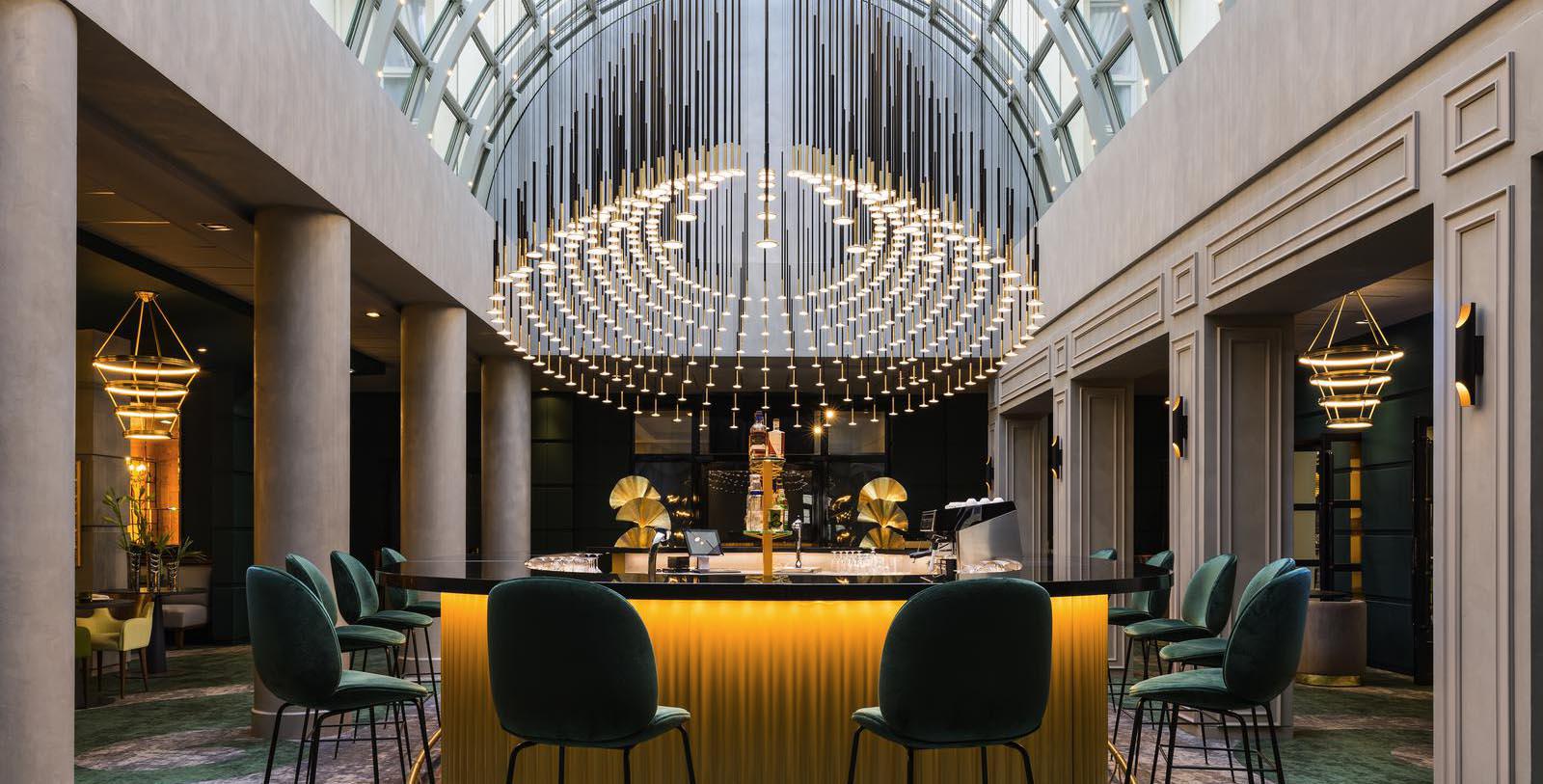Receive for Free - Discover & Explore eNewsletter monthly with advance notice of special offers, packages, and insider savings from 10% - 30% off Best Available Rates at selected hotels.
history
Discover the historic arches that reside at the front of the Hôtel Le Louis Versailles Château - MGallery by Sofitel, which were once part of a military building known as the "Petite Écurie."
Hôtel Le Louis Versailles Château - MGallery by Sofitel, a member of Historic Hotels Worldwide since 2018, dates back to 1854.
VIEW TIMELINEA member of Historic Hotels Worldwide since 2018, Hôtel Le Louis Versailles Château - MGallery by Sofitel sits before the resplendent Palace of Versailles, the location of the legendary French royal court throughout much of the 17th and 18th centuries. During that time, the land that the hotel occupies belonged to the estate. Beautiful sprawling gardens covered the area, mesmerizing the countless guests who traveled to visit the king. Both the palace and its marvelous grounds sprang forth from the genius of one of France’s most illustrious monarchs, Louis XIV. Known to history as the “Sun King,” Louis XIV intended for his majestic home to inspire devotion within the fickle noblemen that populated the realm. Yet, with the execution of Louis XVI at the height of the French Revolution, the nation’s new republican government abandoned the complex. The grand arches that serve as the entrances to the current hotel were built when the Palace of Versailles found new life during the reign of Napoleon Bonaparte’s nephew, Emperor Napoleon III. Under Napoleon III, the estate fulfilled a variety of unique royal functions, such as serving as a lavish venue for official ceremonies. He also developed the immediate vicinity surrounding the palace, too. In 1854, Napoleon III directed the Ministry of War to erect an artillery barracks on the grounds of the estate. It subsequently agency hired architect Charles-Auguste Questel to lead the project. Questel raised the structure in front of the Palace of Versailles upon a segment of its ancient gardens. The building, named “Les Manèges,” became the main training facility for the garrison of horse artillery stationed at the nearby Petite Écurie.
The building was not used for long, as changing tides in France’s military fortunes forced the garrison at Versailles to shrink gradually. As such, its commanders soon considered the barracks to be superfluous and eventually discarded it during the 1970s. When the City of Versailles purchased the facility in 1973, the whole structure was in tatters. Local politicians eventually decided to demolish the structure. The two grand arches were left standing, with one on the Avenue du Général-de-Gaulle and the other on the Avenue de Paris. The arches at these two entrances were classified as historical monuments. Enterprising hoteliers later arrived and rescued the site in the early 1990s, redeveloping the location into a luxury boutique hotel known as the “Hôtel Le Louis.” They incorporated the surviving gateways into the hotel’s layout, making them both act as the main entrance into the building. Pullman Hotels and Resorts managed the business for many years, until the hotel was rebranded as MGallery by Sofitel in 2017. The hotel was subsequently fully renovated, with the redesign of the hotel entrusted to two Russian architects, the Sundukovy Sisters. They decided to showcase the contrasting eras through décor that blends contemporary elegance with classical refinement. The arches of the barracks have been preserved and currently serve as the main entrance to Hôtel Le Louis. They still featured historic details such as cannon and wreath patterns and a capital “N” that references Emperor Napoleon III. Sofitel now proudly operates the building as the “Hôtel Le Louis Versailles Château - MGallery by Sofitel,” and continues to preserve its historical aura for future generations to enjoy.
-
About the Location +
While historical records indicate that a bucolic, pastoral community lived in the area since the early 11th century, modern Versailles did not appear until King Louis XIV constructed his magnificent Château de Versailles, or “Palace of Versailles” in the 17th and 18th centuries. Known to history as the “Sun King,” Louis XIV learned of the region from tales about the hunting trips that his father, Louis XIII, had taken into the region countless times. (A local royal family called the “Gondis” had originally started inviting the king to visit the locale back in the 1610s.) In fact, King Louis XIII had grown so infatuated with the area that he even built a beautiful hunting lodge that double as a quaint country estate. Eager to escape the energetic—and sometimes hectic—atmosphere of the Paris, Louis XIV subsequently instructed his royal architect and chief gardener to transform the retreat into a brilliant royal palace that he could call his primary home. Yet, the Sun King desired that the new estate serve as the permanent location of the French royal court, even going as far as to develop a planned community around the site throughout the 1670s and 1680s.
A beautiful tree-lined avenue acted as the town’s main thoroughfare, which was lined with dozens of outstanding buildings that included churches, markets, and aristocratic mansions. Two primary neighborhoods constituted the heart of Versailles—Notre Dame and Saint Louis—organized upon a series of street grids and preapproved building schematics created by Louis XIV’s chief engineer. Meanwhile, the king’s gorgeous palace gradually took shape. Its stunning Baroque-inspired architecture dominated the local skyline, as an intricate series of manicured gardens wrapped around the exterior. Inside, the gorgeous palace featured a number of amazing rooms, including the renowned Hall of Mirrors, which became the primary reception hall for all of Louis XIV’s grand ceremonies and receptions. When construction had concluded half a century later, it had cost the French crown a millions in Livres to complete! (Louis had also sponsored the creation of another opulent palace in Versailles, as well, the Grand Trianon. Less opulent than the Château de Versailles, it was not the primary palace of any French monarch until Napoleon Bonaparte became emperor in 1799.)
At first, Versailles and its sparkling royal palace were the source of pride among Frenchmen, who pointed to the supposed power of the monarchy that the two projected together. But those attitudes changed rapidly over the course of the 18th century. The might of the Ancien Régime soon turned into a source of bitter discontent among ordinary French subjects, who seethed at the privilege of the royal court. By the time the Sun King’s distant grandson, Louis XVI, ascended the throne in 1774, that animosity was ripe to explode. Protests became frequent in front of the Château de Versailles, especially as France’s economy collapsed due to surging unemployment and rising food costs. To stem the rising anger, the kingdom’s Estates General—an informal assembly consisting of leaders from aristocracy, clergy, and genera public—met at Versailles to discuss possible solutions. But the commoners in attendance remained dissatisfied with the deliberations and subsequently formed the National Assembly, thus, igniting the start of the French Revolution. And while Versailles itself did not suffer any direct hardships from the political instability at the time, it did experience a decline in its political importance with the elimination of the French crown.
The area would not become culturally relevant again until the rise of Louis-Philippe to the vacated French throne during the July Revolution of 1833. He subsequently transformed the palace into a “national museum” and invested heavily into its rehabilitation. His predecessor, Emperor Napoleon III, continued his efforts to save the structure, even going as far as to use the historic palace again as the site for official state-sponsored events. Nevertheless, Versailles remained a fairly quiet town, numbering just a few thousand people by the dawn of the 20th century. But the Château de Versailles managed restore some aspects of its earlier political prestige, going on to host various sessions of the French Parliament in the aftermath of the Franco-Prussian War. (The parliament still meets at Versailles whenever it needs to amend the French Constitution or to receive a joint address from the French president.) Yet, the palace’s greatest moment in modern history occurred when it functioned as the site for the signing of the eponymous Treaty of Versailles, which brought an end to World War I. Today, Versailles and its brilliant palace attract thousands of curious onlookers every year, who wish to immerse themselves deeply into France’s past. The fascinating connection that the Château de Versailles itself shares with French history has even earned it a listing as a rare UNESCO World Heritage Site.
-
About the Architecture +
When AccorHotels tasked the Sundukovy Sisters to completely renovate the Hôtel Le Louis, they decided to recast the building’s whole appearance to resemble the renowned Château de Versailles. Perhaps the greatest focus of their work was the building’s beautiful interior, specifically the ground floor and all of its quaint public areas. The facades new design took direct inspiration from the palace itself, while the Sundukovy Sisters actually used its attending gardens to influence their approach inside. Hues of gold and emerald green—emblematic of the colors of the Versailles Garden—defined the hotel’s lobby. The scheme continued onto the new concrete walls, which the Sundukovys had aged to evoke a sense of memory and place. Moreover, the use of conically shaped design elements intermixed brilliantly with the presence of several ornate carpets to further reinforce the notion that guests were traversing the cone-trimmed vegetation of Versailles’ brilliant landscape. They even saved the historic entry arches of the former barracks, reconfiguring it to serve as the primary entrance within their design. The Sundukovy Sisters specifically preserved such features like its cannon and wreath patterns, as well as the capital “N” that references Emperor Napoleon III.
The general appearance of the Hôtel Le Louis Versailles Château – MGallery by Sofitel displays some beautiful Baroque-themed architecture. Baroque architecture itself can trace its roots back to the start of the 17th century, when French architects began to practice the style en masse. The architectural form specifically materialized in the wake of the Mannerist design aesthetics that had preceded it at the height of the Renaissance. The French had begun to mimic a new architectural school of thought that had debuted further south in the Italian Peninsula. The Vatican had grown weary of its declining influence across Europe amid the Protestant Reformation and sought innovative ways to demonstrate its cultural power. One of the many avenues that the church ultimately embraced was the use of architecture as a means of showcasing its wealth and prestige. As such, the Italian architects under its employ started creating massive structures that placed a greater emphasis on opulence and grandeur. Inspired by the movement, many French noblemen incorporated similar design principles into their own buildings.
But while the style quickly became ubiquitous across France, its greatest champion was the French king, namely Louis XIV. Known to history as the “Sun King,” he particularly enjoyed the idea of “Baroque” architecture as source of power. He subsequently used it to create the Grand Trianon and Les Invalides. Yet, Louis had also used Baroque architecture to completely transform his father’s quaint hunting estate outside of Paris into the luxurious Château de Versailles. What made Baroque so attractive to the French aristocracy was its use of grandiose details to achieve an awe-inspiring ambiance. French architects achieved such a feat by making use of such elements like colonnades, cupolas, domes, cartouches, and extensive gilding. Brilliant artwork adorned the walls inside French-inspired Baroque structures, too, appearing either as a quadratura, or trompe-l'œil paintings. Yet, the style also called for relied greatly on symmetry, in which highly stratified floorplans granted a sense of hierarchy and order. Interestingly, the development of the surrounding landscape was also an integral component to Baroque structures, as manicured gardens helped to reinforce their aura of great magnificence.


























